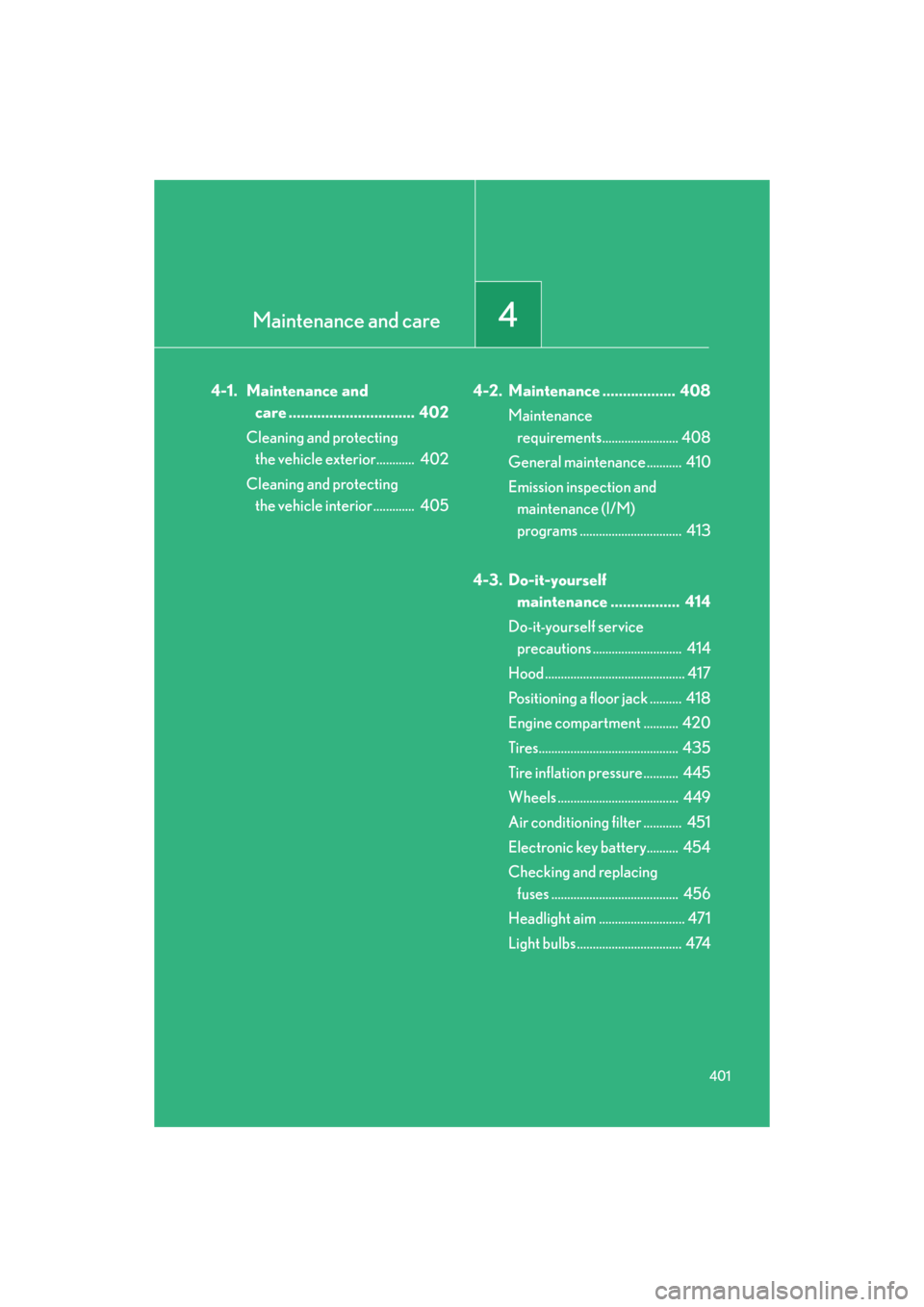Page 218 of 596

218
2-5. Driving information
GS_HV_U
December 12, 2007 3:50 pm
■Snow chain installation
Observe the following precautions when installing and removing chains.
●Install and remove tire chains in a safe location.
●Install tire chains on the rear tires only. Do not install tire chains on front tires.
●Install tire chains following the instructions provided in the accompanying
instructions.
CAUTION
■Driving with snow tires
Observe the following precautions to reduce the risk of accidents.
Failing to do so may result in a loss of vehicle control and cause death or serious
injury.
●Use tires of the size specified for your vehicle.
●Maintain the specified level of tire inflation pressure.
●Do not drive in excess of 75 mph (120 km/h ), regardless of the type of snow tires
being used.
●Use snow tires on all, not just some wheels.
■Driving with snow chains
Observe the following precautions to reduce the risk of accidents.
Failing to do so may result in the vehicle being unable to be driven safely, and may
cause death or serious injury.
●Do not drive in excess of the speed limit specified for the tire chains being used,
or 30 mph (50 km/h), whichever is lower.
●Avoid driving on bumpy road surfaces or over potholes.
●Avoid sudden turns and braking, as use of chains may adversely affect vehicle
handling.
●Slow down sufficiently before entering a curve to ensure that vehicle control is
maintained.
Page 219 of 596
219
2-5. Driving information
2
When driving
GS_HV_U
December 12, 2007 3:50 pm
NOTICE
■Repairing or replacing snow tires
Request repairs of and obtain replacement snow tires from Lexus dealers or legiti-
mate tire retailers.
This is because the removal and attachment of snow tires affects the operation of
the tire pressure warning valves and transmitters.
■Fitting tire chains
The tire pressure warning valves and transmitters may not function correctly when
tire chains are fitted.
Page 401 of 596

Maintenance and care4
401
GS_HV_U
December 12, 2007 3:30 pm
4-1. Maintenance and
care ............................... 402
Cleaning and protecting
the vehicle exterior............ 402
Cleaning and protecting
the vehicle interior ............. 405 4-2. Maintenance .................. 408
Maintenance
requirements........................ 408
General maintenance ........... 410
Emission inspection and
maintenance (I/M)
programs ................................ 413
4-3. Do-it-yourself
maintenance ................. 414
Do-it-yourself service
precautions ............................ 414
Hood ............................................ 417
Positioning a floor jack .......... 418
Engine compartment ........... 420
Tires............................................ 435
Tire inflation pressure........... 445
Wheels ...................................... 449
Air conditioning filter ............ 451
Electronic key battery.......... 454
Checking and replacing
fuses ........................................ 456
Headlight aim ........................... 471
Light bulbs ................................. 474
Page 412 of 596
412
4-2. Maintenance
GS_HV_U
December 12, 2007 3:50 pm
Vehicle exterior
ItemsCheck points
Doors/trunk• Operate smoothly?
Engine hood• The lock system works properly?
Fluid leaks• Is there any leakage after parking?
Ti r e
• Inflation pressure is correct?
• Tire surfaces not worn or dam-aged?
• Tires rotated according to the
maintenance schedule?
• Wheel nuts are not loose?
CAUTION
■If the hybrid system is running
Turn off the hybrid system and ensure that there is adequate ventilation before per-
forming maintenance checks.
Page 435 of 596
435
4-3. Do-it-yourself maintenance
4
Maintenance and care
GS_HV_U
December 27, 2007 1:38 pm
Tires
Replace or rotate tires in accordance with maintenance schedule and
treadwear.
■Checking tires
New tread
Treadwear indicator
Worn tread
The location of treadwear indi-
cators is shown by the “TWI” or
“ ” marks, etc., molded on the
sidewall of each tire.
Check spare tire condition and
inflation pressure if not rotated.
■Tire rotation
Rotate the tires in the order
shown.
To equalize tire wear and extend
tire life, Lexus recommends that
tire rotation is carried out at the
same interval as tire inspection.
■The tire pressure warning system
Your Lexus is equipped with a tire pressure warning system that uses
tire pressure warning valves and tr ansmitters to detect low tire infla-
tion pressure before serious problems arise. ( P. 493, 501)
Front
Page 436 of 596

436
4-3. Do-it-yourself maintenance
GS_HV_U
December 27, 2007 1:38 pm
Installing tire pressure warning valves and transmittersWhen replacing tires or wheels, tire pressure warning valves and trans-
mitters must also be installed.
When new tire pressure warning va lves and transmitters are installed,
new tire pressure warning valve and transmitter ID codes must be regis-
tered in the tire pressure warning computer and tire pressure warning
system must be initialized. Have tire pressure warning valve and transmit-
ter ID codes registered by your Lexus dealer. ( P. 4 3 8 )
Initializing the tire pressure warning system
■ The tire pressure warning system must be initialized in the following
circumstances:
● When rotating the tires on vehicles differing with front and rear tire
inflation pressures.
● When changing the tire inflation pressure by changing traveling
speed or load weight, etc.
When the tire pressure warning sys tem is initialized, the current tire
inflation pressure is set as the pressure benchmark.
Page 438 of 596

438
4-3. Do-it-yourself maintenance
GS_HV_U
December 27, 2007 1:38 pm
Registering and selecting ID codes■ Registering ID codes
2 sets of tire pressure warning va lve and transmitter ID codes can be
registered. Once a second set of ti res is registered at “2nd”, you can
switch between tire set settings simply by pressing the tire pressure
warning select switch.
There are 2 settings:
“MAIN” position: The ID code of the tire pressure warning valve and
transmitter on the tires originally inst alled on the vehicle is registered.
“2nd” position: The ID code is not registered. When you replace a new
set of tires, purchase tire pressu re warning valves and transmitters
from your Lexus dealer and have the new ID code registered by your
Lexus dealer.
■ Selecting ID codes
When replacing tires, make sure to select the ID code set that matches
the new tire set. If the tire pressure warning select switch is set to the
wrong tire setting, the tire pressu re warning system will not operate
properly. After driving for about 20 minutes, the tire pressure warning
light comes on after blinking for 1 minute to indicate a system malfunc-
tion.
“MAIN”
“2nd”
Page 439 of 596

439
4-3. Do-it-yourself maintenance
4
Maintenance and care
GS_HV_U
December 27, 2007 1:38 pm
■When to replace your vehicle’s tires
Tires should be replaced if:
●You have tire damage such as cuts, splits, cracks deep enough to expose the
fabric or bulges indicating internal damage
●A tire goes flat repeatedly or cannot be properly repaired due to the size or
location of a cut or other damage
If you are not sure, consult with your Lexus dealer.
■Replacing tires and wheels
If the ID code of the tire pressure warn ing valve and transmitter is not registered,
the tire pressure warning system will not work properly. After driving for about 20
minutes, the tire pressure warning light comes on after blinking for 1 minute to indi-
cate a system malfunction.
■Tire life
Any tire over 6 years old must be checked by a qualified technician even if they
have seldom or never been used or damage is not obvious.
■If the tread wears down below 0.16 in. (4 mm) on snow tires
The effectiveness of snow tires is lost.
■Low profile tires (245/40R18, P245/40R18 and 245/40ZR18 tires)
Generally, low profile tires will wear more rapidly and tire grip performance will be
reduced on snowy and/or icy roads when co mpared to standard tires. Be sure to
use snow tires or snow chains on snowy and/or icy roads and drive carefully at a
speed appropriate for road and weather conditions.
■Initializing the tire pressure warning system
Initialize the tires with the tire inflatio n pressure adjusted to the specified level.